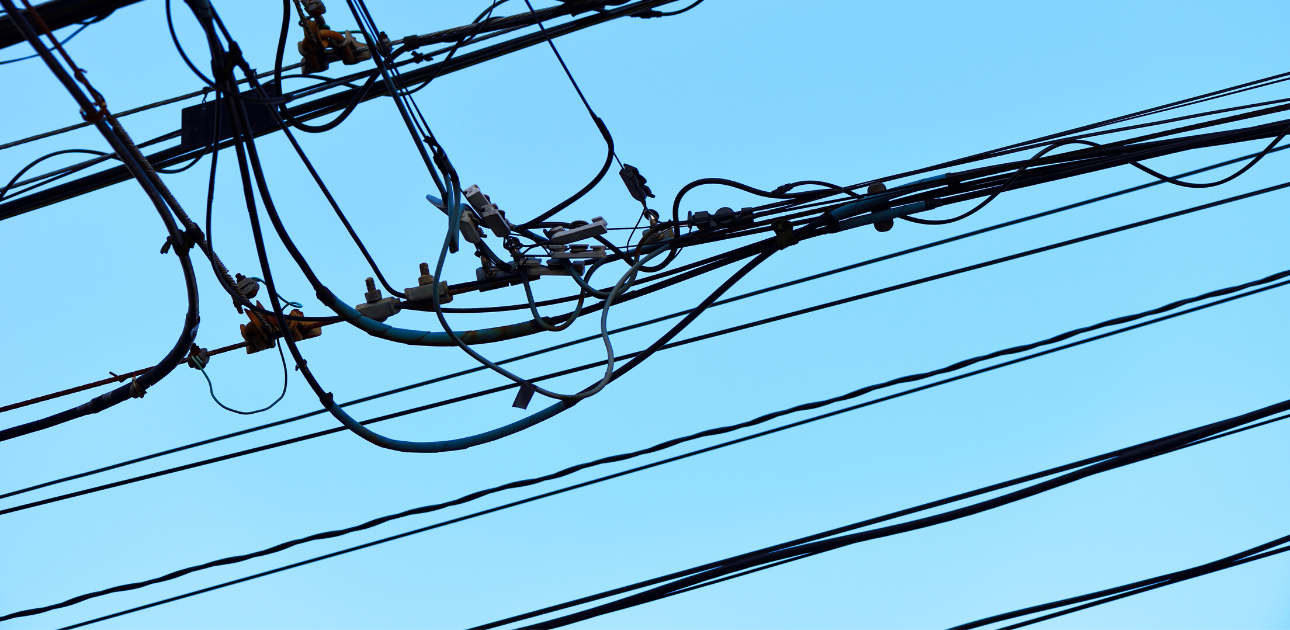Access to electricity is a fundamental right, yet rampant power theft in Delhi negatively impacts the economy and endangers lives. At the same time, it is used by those in power to intimidate people and stifle dissent.
—
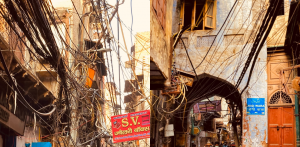


JUMBLED wires, soldering and street lights … and the meter blinks, a little too slowly.
Irrfan, 29, who prefers to go by his first name, belongs to a theft-prone area in southeast Delhi. Previously, he and his friends have committed power theft by directly stealing power from a street light, which he claims was out of necessity during exam seasons.
Access to electricity
As most of the overhead electrical wires are still not insulated, it facilitates illegal hook-ups. He says that access to electricity, which officials claim to be ‘easy’, has been a heavily bureaucratic process for most people in his community.
“Ek do bar kiya hai. Majboori thi … bacho k exams chal rahe the. Hum sab ne mil k gali ki ek street light se bijli le li thi. YouTube pr bohut sare videos hai joh batate hai kaise karna hai.” [(I) have done (power theft) once or twice. It was a necessity, the kids’ exams were going on. So, we took electricity from a nearby street light. There are a lot of videos on YouTube which tell you how to do power theft.]
The power sector in Delhi was privatised 21 years ago, in July 2002. At the time of privatisation, the losses were around 53 percent and have now been curbed to under 9 percent. However, annual losses of ₹400 crore in power theft are incurred by power supplying authorities in Delhi.
An enforcement official from a discom, on conditions of anonymity, says that only the “majboor aur mazboot” (helpless and powerful) do power theft.
Before privatisation, it was alleged that the Delhi Vidyut Board (DVB) was heavily corrupt, disorganised and faced strong public resentment. “In a large number of cases, meter readers were hand in glove with power thieves; they advised consumers how to give a gloss of legality to the theft they were indulging in,” say Dr Debi S. Saini and Dr Jyotsna Bhatnagar in their paper titled Change Dynamics at North Delhi Power.
The government of Delhi handed over management of electricity distribution to three private companies: BSES Rajdhani Power Limited (BRPL); BSES Yamuna Power Limited (BYPL); and Tata Power Delhi Distribution Limited (TPDDL), erstwhile NDPL.
Electricity subsidies in Delhi
In 2015, the Aam Aadmi Party (AAP) released its 12-page manifesto before the Delhi state assembly elections. Subsequently, the party won 67 of the 70 seats in assembly. Item 4 of the manifesto said, “Electricity bills to be reduced by half: An Aam Aadmi Party government will keep its promise of reducing electricity bills by half… AAP will take measures to provide relief from rising power bills, namely generating cheaper electricity, improving transmission efficiency, fixing billing defects and correcting meter defects.”
In 2019, it was announced that electricity bills need not be paid for consumption of up to 200 units. Under this scheme, consumers who use less than 200 units of power per month would not get charged any money at all in their bill. Those who use up to 400 units get a subsidy of 50 percent up to ₹800.
A total of ₹3,250 crore was allocated by the Kejriwal government for power subsidy in Delhi Budget 2023–24. According to the Delhi Government Performance Report 2022, of around 58 lakh electricity consumers in Delhi, 47 lakh got a subsidy on a monthly average. Of these, 30 lakh households pay nothing and around 16–17 lakh households get the 50 percent subsidy.
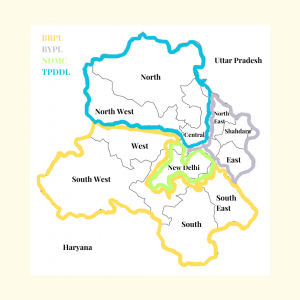


The law on electricity theft
It is said that the practice of stealing electricity is nearly as old as electricity distribution itself. In Katiyabaaz (2013), a documentary film by Fahad Mustafa and Deepti Kakkar, electricity is characterised almost as a divine being.
Capricious yet meticulous and omnipotent, it sustains livelihoods, inspires worship and incites riots alike. In the documentary, the breach in adequate supply and vast demand becomes the opportunity for local electricity thieves who provide illegal power connection to people by plugging into official supply through live wires.



Unauthorised use of electricity is a cognisable offence, under the provisions of the Electricity Act, 2003 (Act). Under Section 135 of the Act, power theft attracts a penalty and up to five years imprisonment. According to power distribution companies (discoms), in the last one decade, as many as 10,000 people have been arrested and 1,200 convicted for stealing electricity in Delhi.
Tampering with electricity
Junaid, 34, an electrician in the New Friends Colony, explains how power theft happens. According to him, the oldest method is attaching one’s wire to someone else’s power cable, a method referred to as “katiya”. Overhead cables jumbled over one another may be indicators of theft. The old manual meters were easy to tamper with, but the displays of digital meters are more difficult to manipulate.
An enforcement official lost his hearing ability in one ear after being beaten up and locked in a room by power thieves. Attacks on enforcement officials are not uncommon.
He says, “Pehle toh manual meters the. Toh log meter jala dete the taki band hojaye. Seal ko tod dete the, ya uskey andar plastic dalte the. Per ab electric meters agaye hai, toh mushkil hai. Ab log magnet use karte hai ya voltage dalte hai bahar se jisse meter slow hojata hai ya band hojata hai.” (Earlier, there used to be manual meters. People would burn the meter to make it stop. People would break the seal or insert plastic inside it. But now, electric meters are installed they are more difficult to manipulate. So, people use magnets or insert (high) voltages which slows the meter or stops it.)
Illegal soldering slows down the meter. With a specific device, enforcement officials can check how much the meter has been slowed down. Direct theft refers to directly stealing from electricity in public spaces, for example, a street light.
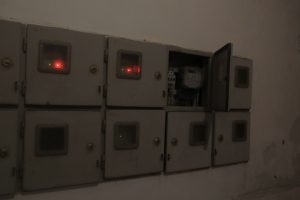


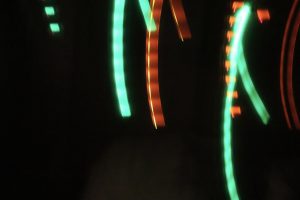


The impact on electricity workers
An electricity enforcement official from a discom, on conditions of anonymity, says that only the “majboor aur mazboot” (helpless and powerful) do power theft. According to him, the helpless steal simply because they cannot afford to pay even the subsidised bills, while affluent families steal power out of sheer unwillingness to pay hefty bills. By not paying hefty electricity bills, the affluent also evade paying consequential taxes for electricity consumption.
He says that discom employees have always borne the brunt of violence in highly theft prone areas. According to him, an enforcement official lost his hearing ability in one ear after being beaten up and locked in a room by power thieves.
Attacks on enforcement officials are not uncommon. In the Bajitpur village in North Delhi, which reported over 49 percent losses in 2018, the raid team of TPDDL, along with local police, were met with attacks by local strongmen. TDPPL’s former CEO Sanjay Banga is on record for saying “Nuisance by local strongmen, attacks and hindrances to enforcement raids are some of the major reasons for rampant electricity thefts in these areas.” Some years back, a similar attack led to the death of an electricity official of BSES, besides causing injury to four others in Jhul Jhuli village in Jaffarpur, West Delhi.
Poverty and power theft
Residents of high-theft prone areas (typically lower income spaces) allege that big corporations (discoms) are run by private interests and corruption.
Several slums in Delhi are unauthorised, and subsequently unelectrified; therefore they rely heavily on stealing electricity. Furthermore, people belonging to the high-power theft prone areas allege that most officials are corrupt and amenable to bribery.
Aqib, 28, Irrfan’s friend, who also prefers to go by his first name, says that “elections ke waqt yeh sab par koi (politician) baat nahi karta kyu ki fir hum vote nahi denge” (during election time, politicians refrain from referring to power theft to not jeopardise their vote bank). Subsequently, power theft increases during elections. However, it also increases during marriage season, ‘Ram Leela’ (festival of Ram), and melas (fairs).
However, enforcement official maintains that access to electricity is not difficult. “It is extremely easy to apply for a meter. Most of them do power theft because they do not want to pay any bills. They tamper with (electronic) meters with magnets and jammers and then say ‘Meter hi kharab hai’ (The meter itself has malfunctioned). It does not leave any physical evidence of tampering. When the raid team arrives, they can get violent. The (discom) company incurs huge losses because of power theft.”
In January this year, additional sessions judge Vinay Singhal, in an Order, said, “the theft of electricity is an economic offence whereby the society as a whole is a victim and it is not an offence committed against any particular individual.”
The politics of electricity
Political tussles between the Union government and the state governments are a hurdle in accessing electricity. In April this year, Delhi’s power minister Atishi, from the ruling Aam Aadmi Party, had announced that subsidised electricity will be stopped from April 15, 2023, due to stalling of the file by the lieutenant governor’s office.
Electricity is used as a tool to stifle dissent and the incident at Jantar Mantar is not unprecedented.
Soon after being accused by the Aam Aadmi Party of not extending the power subsidy, the Lt governor V.K. Saxena’s office had reportedly cleared the file, enabling the continuation of the scheme.
Also read: Delhi government, not LG, controls bureaucracy: Supreme Court verdict
Furthermore, access to electricity, despite generous policy changes, remains a political tool. Hours after the Delhi police registered two first information reports (FIR) against Wrestling Federation of India (WFI) President Brij Bhushan Sharan Singh on April 28, Olympic medalist Bajran Punia took to Instagram alleging that electricity was cut off at the wrestlers’ protest site at Jantar Mantar.
Electricity is used as a tool to stifle dissent and the incident at Jantar Mantar is not unprecedented. Earlier this year, in January, electricity was cut off at the Jawaharlal Nehru University’s campus in Delhi, during the screening of a BBC documentary that is critical of Prime Minister Narendra Modi’s role in the Gujarat pogrom. Consistent and unscheduled power cuts in disputed areas such as Kashmir highlight how access to electricity is used as a political tool.
In 2022, the High Court of Delhi observed that electricity is part of the fundamental right to life under Article 21 of the Constitution in the case of Ashish Gupta versus Tata Power Delhi Distribution Limited.
Area-wise impact of power theft
Data on unelectrified areas in the jurisdiction covered by BSES shows that most areas are residential, with the highest unelectrified areas in Shyam Vihar and Chhawla village.
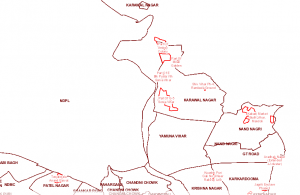


Power theft is rampant in areas of Najafgarh, Jaffarpur, Mundka, Karawal Nagar, Seelampur, Mandawali, Chandni Mahal, Nangloi, Nand Nagri, Yamuna Vihar, Daryaganj, Dallupura, Khichripur, Shastri Park, Baljeet Nagar, Sabhapur village, Burari, Jahangirpuri, Wazirabad, Karawal Nagar, Shaheen Bagh, Madanpur Khadar, Begumpur, Munirka village, Gautam Nagar and Madandir.
According to the BSES website, in 2018, Chandni Chowk, Daryaganj, Paharganj, Mayur Vihar, Karkardooma, Krishna Nagar, Yamuna Vihar and Nand Nagri witnessed the most power theft cases. The losses were as high as 78.28 percent in the affluent Yamuna Vihar (Northeast Delhi).
Certain areas of Badli, Bawana, Civil Line, Keshavpuram, Kirari, Model Town, Mangolpuri, Moti Nagar, Neral, Pitampura, Rohini and Shalimar Bagh, under TPDDL jurisdiction, remain unelectrified. Most of these areas are classified as ‘remote’ and ‘outskirts village area’, according to an official from TPDDL.
TPDDL refused to share recent data on unelectrified areas and high power theft prone areas of Delhi. BSES and NDMC are yet to respond with recent data on the same.
When asked if power theft has decreased, an enforcement official said that the team sizes of their department have significantly gone down, indicating lesser power theft cases. However, he feels that electricity and power theft are yoked together. He says “Jab tak bijli hai, tab tak katiyabaazi hai” (as long as there is electricity, there will be power theft).

